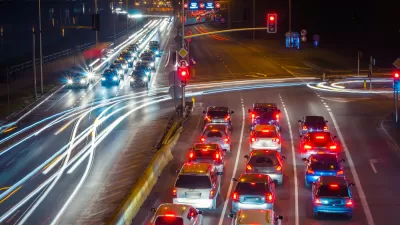The graph below shows the most recent USDOT vehicle-travel data covering the last 25 years. Although vehicle-miles of travel (VMT) grew steadily during most of the Twentieth Century, in recent years the growth rate stopped and even declined a little. It is now about 10% below where it would have been had past trends continued.
The graph below shows the most recent USDOT vehicle-travel data covering the last 25 years. Although vehicle-miles of travel (VMT) grew steadily during most of the Twentieth Century, in recent years the growth rate stopped and even declined a little. It is now about 10% below where it would have been had past trends continued.

This is particularly notable because during this period both population and economic activity grew, so VMT per capita and per unit of economic activity declined. This has important implications for planners.
The Twentieth Century was the period of automobile ascendency, during which personal motor vehicles grew from virtually nothing to becoming the dominant travel mode in most developed countries. During this period it made sense to invest in automobile-oriented infrastructure: paved roads, highways and parking facilities. However, demographic and economic trends are changing travel demands. Aging population, rising fuel prices, increasing urbanization, increasing traffic congestion, improvements in alternative modes, changing consumer preferences, and increased health and environmental concerns are all reducing demand for automobile travel and increasing demands for travel by other modes. Although automobile travel will not disappear, it will not grow as it did in the past, and in many developed countries motor vehicle travel will be flat or negative in the future.
This requires a major change in the way we think about transportation problems and evaluate solutions. Most state and regional transportation plans are based on the assumption that VMT will continue to grow as it did in the past, so the primary problem is traffic congestion. The decline in VMT growth indicates that traffic congestion problems will be less severe and other problems will become more important, including inadequate mobility options for non-drivers, transit crowding, transport affordability, and environmental concerns.
This suggests that policies and projects which help create a more diverse and efficient transportation system will be the most cost effective solutions to the diverse problems communities face, while the need to expand roads and parking facilities will decline.
This is good news for transport planners and engineers, provided that your interests and skills align with these trends. Experts in pedestrian and bicycle planning, streetscaping, parking management, public transportation planning, roadway operations, smart growth/new urbanist development, efficient transport pricing, and energy efficient transport planning, to name a few related specialty areas, will have skills that communities need.
For more information
Dan Brand (2009), Impacts of Higher Fuel Costs, Federal Highway Administration, (www.fhwa.dot.gov); at www.fhwa.dot.gov/policy/otps/innovation/issue1/impacts.htm.
Heather Contrino and Nancy Mcguckin (2009), "Travel Demand in the Context of Growing Diversity: Considerations for Policy, Planning, and Forecasting," TR News, Transportation Research Board (www.trb.org), September-October, pp. 4-9; at http://onlinepubs.trb.org/onlinepubs/trnews/trnews264TravelDemand.pdf.
Todd Litman (2006), The Future Isn't What It Used To Be: Changing Trends And Their Implications For Transport Planning, Victoria Transport Policy Institute (www.vtpi.org); at www.vtpi.org/future.pdf; originally published as "Changing Travel Demand: Implications for Transport Planning," ITE Journal, Vol. 76, No. 9, (www.ite.org), September, pp. 27-33.
Todd Litman (2009), Where We Want To Be: Home Location Preferences And Their Implications For Smart Growth, Victoria Transport Policy Institute (www.vtpi.org); at www.vtpi.org/sgcp.pdf.
Adam Millard-Ball and Lee Schipper (2010), Are We Reaching A Plateau Or "Peak" Travel? Trends In Passenger Transport In Six Industrialized Countries, 2010 Transportation Research Board Annual Meeting (www.trb.org); at www.stanford.edu/~adammb/Publications/Millard-Ball%20Schipper%202010%20Peak%20travel.pdf.
Arthur C. Nelson (2006), "Leadership in a New Era: Comment on "Planning Leadership in a New Era," Journal of the American Planning Association, Vol. 72, Is. 4, Dec. 2006 , pp. 393 – 409. Also see Arthur C. Nelson (2009), The New Urbanity: The Rise of a New America, University of Utah Metropolitan Research Center; summary at www.froogalizer.com/news/research-on-homeownership-rate-through-2030.html.
Robert Puentes (2008), The Road Less Traveled: An Analysis of Vehicle Miles Traveled Trends in the U.S., Brooking Institution (www.brookings.edu); at www.brookings.edu/reports/2008/1216_transportation_tomer_puentes.aspx?emc=lm&m=220694&l=17&v=39243.
Stuart Ramsey and David Hughes (2009), "The Challenge of the Oracle: Optimizing Transportation Infrastructure in a Changing World," ITE Journal, Vo. 79, No. 2 (www.ite.org), pp. 69-73. www.transportplanet.ca/WriteTheChallengeOfTheOracle.pdf.
Nate Silver (2009), "The End Of Car Culture: It's Not Just Erratic Gas Prices And A Bad Economy That's Hurting Automakers. It May Be That Americans Are Changing," Esquire (www.esquire.com); at www.esquire.com/features/data/nate-silver-car-culture-stats-0609.
Gary Toth (2007), "Back To Basics In Transportation Planning: Rediscovering Our Roots Can Solve 21st Century Traffic Woes," Making Places Bulletin, Project for Public Spaces (www.pps.org); at www.pps.org/info/bulletin/back_to_basics_in_transportation.
USDOT (2010), Traffic Volume Trends, U.S. Department of Transportation (www.dot.gov); at www.fhwa.dot.gov/ohim/tvtw/10aprtvt/10aprtvt.pdf.

Planetizen Federal Action Tracker
A weekly monitor of how Trump’s orders and actions are impacting planners and planning in America.

Maui's Vacation Rental Debate Turns Ugly
Verbal attacks, misinformation campaigns and fistfights plague a high-stakes debate to convert thousands of vacation rentals into long-term housing.

San Francisco Suspends Traffic Calming Amidst Record Deaths
Citing “a challenging fiscal landscape,” the city will cease the program on the heels of 42 traffic deaths, including 24 pedestrians.

Defunct Pittsburgh Power Plant to Become Residential Tower
A decommissioned steam heat plant will be redeveloped into almost 100 affordable housing units.

Trump Prompts Restructuring of Transportation Research Board in “Unprecedented Overreach”
The TRB has eliminated more than half of its committees including those focused on climate, equity, and cities.

Amtrak Rolls Out New Orleans to Alabama “Mardi Gras” Train
The new service will operate morning and evening departures between Mobile and New Orleans.
Urban Design for Planners 1: Software Tools
This six-course series explores essential urban design concepts using open source software and equips planners with the tools they need to participate fully in the urban design process.
Planning for Universal Design
Learn the tools for implementing Universal Design in planning regulations.
Heyer Gruel & Associates PA
JM Goldson LLC
Custer County Colorado
City of Camden Redevelopment Agency
City of Astoria
Transportation Research & Education Center (TREC) at Portland State University
Jefferson Parish Government
Camden Redevelopment Agency
City of Claremont




























